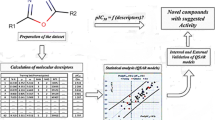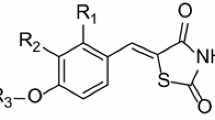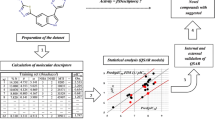Abstract
Series of mono-, di-, and triaryl substituted tetrahydropyrans were taken for quantitative structure–activity relationship (QSAR) study using density functional theory-based (DFT-based) quantum chemical and empirical descriptors. Several QSAR equations were formulated through regression analysis, which were able to explain 93–98 % of the variance in the data. The best equations were selected from the various statistically significant equations by following established statistical procedures. The model equations revealed that the presence of 4-cholorobenzene at R1 position is favorable for the activity and the presence of 4-bromo benzene at R1 position seems to be unfavorable for the activity, however, DFT-based descriptors demonstrate that the high values of HOMO and softness whereas low values of LUMO, hardness, and absence of –CH3 group at R1 position enhances the activity. The predictive ability of equations were cross validated by evaluating of the residual activity and R 2 values and also by leave one out (LOO) technique.


Similar content being viewed by others
References
Acd-Lab software for calculating the referred physicochemical parameters. Chem Sketch. www.acdlabs.com/acdlabs-rss-feed.xml. Accessed 12 May 2014
Agarwal VK, Bano S, Khadikar PV (2003) Topological approach to quantifying molecular lipophilicity of heterogenous set of organic compounds. Bioorg Med Chem 11:4039–4047
Agarwal VK, Gupta M, Singh J, Khadikar PV (2005) A novel method of estimation of lipophilicity using distance based topological indices: dominating role of equalized electronegativity. Bioorg Med Chem 13:2109–2120
Agarwal VK, Singh J, Louis B, Khadikar PV (2006) The topology of molecule and its lipophilicity. Curr Comput Aided Des 2:369–403
Allison MC, Howatson AG, Torrance CJ, Lee FD, Russell RI (1992) Gastrointestinal damage associated with the use of nonsteroidal antiinflammatory drugs. N Engl J Med 327:749–754
Bikash D, Shovanlal G, Subrata B, Soma S, Tarun J (2003) QSAR study on some pyridoacridine ascididiamine analogues as antitumor agents. Bioorg Med Chem 11:5493–5499
Capone ML, Tacconelli S, Francesco LD, Sacchetti A, Sciulli MG, Patrignani P (2007) Pharmacodynamic of cyclooxygenase inhibitors in humans. Prostaglandins Other Lipid Mediat 82:85–94
Chaterjee S, Hadi AS, Price B (2000) Regression analysis by example, 3rd edn. Wiley VCH, New York
Cramer RD III, Bunce JD, Patterson DE, Frank IE (1988) Cross validation, bootstrapping, and partial least squares compared with multiple regression in conventional QSAR studies. Quant Struct Act Relat 7:18–25
Devereux M, Popelier P, McLay I (2009) Quantum isostere database: a web-based tool using quantum chemical topology to predict bioisosteric replacements for drug design. J Chem Inf Model 49:1497–1513
Diudea MV (2001) QSPR/QSAR studies for molecular descriptors. Nova Science, Huntington
Dwivedi A, Srivastava AK, Singh A (2013a) Quantitative structure–activity relationship based modeling of substituted indole Schiff bases as inhibitor of COX-2. J Saudi Chem Soc. doi: 10.1016/j.jscs.2013.01.007
Dwivedi A, Srivastava AK, Singh A (2013b) Molecular modeling of pyridine derivatives for COX-2 inhibitors: quantitative structure activity relationship study. Med Chem Res 23:1865–1877
FitzGerald GA, Patrono C (2001) Drug therapy: the coxibs, selective inhibitors of cyclooxygenase-2. N Engl J Med 345:433–442
Frisch MJ, Trucks GW, Schlegel HB, Scuseria GE, Robb MA, Cheeseman JR, Montgomery JA, Vreven JT, Kudin KN, Burant JC, Millam JM, Iyengar SS, Tomasi J, Barone Mennucci VB, Cossi M, Scalmani G, Rega N, Petersson GA, Nakatsuji H, Hada M, Ehara M, Toyota K, Fukuda R, Hasegawa J, Ishida M, Nakajima T, Honda Y, Kitao O, Nakai H, Klene M, Li X, Knox JE, Hratchian HP, Cross JB, Adamo C, Jaramillo J, Gomperts R, Stratmann RE, Yazyev O, Austin AJ, Cammi R, Pomelli C, Ochterski JW, Ayala PY, Morokuma K, Voth GA, Salvador P, Dannenberg JJ, Zakrzewski VG, Dapprich S, Daniels AD, Strain MC, Farkas O, Malick DK, Rabuck AD, Raghavachari K, Foresman JB, Ortiz JV, Cui Q, Baboul AG, Clifford S, Cioslowski J, Stefanov BB, Liu G, Liashenko A, Piskorz P, Komaromi I, Martin RL, Fox DJ, Keith T, Al-Laham MA, Peng CY, Nanayakkara A, Challacombe M, Gill PMW, Johnson B, Chen W, Wong MW, Gonzalez C, Pople JA (2003) GAUSSIAN 03, Revision B.05. Gaussian, Inc., Pittsburgh, PA
Hansch C, Hoekaman D, Gao H (1996) Comparative QSAR: toward a deeper understanding of chemicobiological interaction. Chem Rev 96:1045–1075
Hui-Ding X (2009) 2D-QSAR studies on the norcantharidin analogues as protein phosphatase 1 and 2A inhibitors. Chin J Struct Chem 28:621–627
Jonsdottir S, Jorgensen F, Brunak S (2005) Prediction methods and databases within chemoinformatics: emphasis on drugs and drug candidates. Bioinformatics 21:2145–2160
Karelson M (2000) Molecular descriptors in QSAR/QSPR. Wiley, New York
Khadikar PV, Singh S, Srivastava A (2002) Novel estimation of lipophilic behavioural polychlorinated biphenyls. Bioorg Med Chem Lett 12:1125–1128
Khadikar PV, Singh S, Mandoloi D, Joshi S, Bajaj AV (2003a) QSAR study on bioconcentration factor (BCF) of polyhaloginated biphenlys using the PI index. Bioorg Med Chem 11:5045–5050
Khadikar PV, Mandoloi D, Bajaj AV, Joshi S (2003b) QSAR study on solubility of alkanes in water and their partition coefficient in different solvent system using PI index. Bioorg Med Chem Lett 13:419–422
Khadikar PV, Jaiswal M, Gupta M, Mandoloi D, Sisodia RS (2005a) QSAR studies on 1,2 dithiol-3-thiones: modeling of lipophilicity, quinone reductase specific activity and production of growth hormone. Bioorg Med Chem Lett 15:1249–1255
Khadikar PV, Sharma V, Verma RG (2005b) Novel estimation of lipophilicity using 13C NMR chemical shifts as molecular descriptor. Bioorg Med Chem Lett 15:421–425
Kubinyi H (1997) QSAR and 3D QSAR in drug design part 1: methodology. Drug Discov Today 2:457–467
Muller K, Altmann R, Prinz H (2001) 2-Arylalkyl-substituted anthracenones as inhibitors of 12-lipoxygenase enzymes. 1. Structure–activity relationships of the terminal aryl ring. Eur J Med Chem 36:569–575
Parr RG, Chattaraj PK (1991) Principle of maximum hardness. J Am Chem Soc 113:1854–1855
Parr RG, Pearson RG (1983) Absolute hardness: companion parameter to absolute electronegativity. J Am Chem Soc 105:7512–7516
Parr RG, Donnelly RA, Levy M, Palke WE (1978) Electronegativity: the density functional view point. Chem Phys 68:3801–3807
Parr RG, Szentpaly LV, Liu S (1999) Electrophilicity index. J Am Chem Soc 121:1922–1924
Pauling I (1960) The nature of the chemical bond, 3rd edn. Cornell University Press, Ithaca
Paulose-Ram R, Hirsch R, Dillon C, Gu Q (2005) Frequent monthly use of selected non-prescription and prescription non-narcotic analgesics among U.S. adults. Pharmacoepidemiol Drug Saf 14:257–266
Pereira F, Latino DARS, Aires-de-Sousa J (2011) Estimation of Mayr electrophilicity with a quantitative structure–property relationship approach using empirical and DFT descriptors. J Org Chem 76:9312–9319
Perkins R, Fang H, Tong W, Welsh W (2003) Quantitative structure–activity relationship methods: perspectives on drug discovery and toxicology. Environ Toxicol Chem 22:1666–1679
Pogliani L (1994) Structural property relationships of amine acids and some peptides. Amino Acids 6:141–156
Pogliani L (1996) Modeling with special descriptors derived from a medium size set of connectivity indices. J Phys Chem 100:18065–18077
Seibert K, Zhang Y, Leahy K, Hauser S, Masferrer J, Perkins W, Lee L, Isakson P (1994) Pharmacological and biochemical demonstration of the role of cyclooxygenase 2 in inflammation and pain. Proc Natl Acad Sci USA 91:12013–12017
Simmons DL, Botting RM, Hla T (2004) Cyclooxygenase isozymes: the biology of prostaglandin synthesis and inhibition. Pharmacol Rev 56:387–437
Singh P, Bhardwaj A (2010) Mono-, di-, and triaryl substituted tetrahydropyrans as cyclooxygenase-2 and tumor growth inhibitors. Synthesis and biological evaluation. J Med Chem 53:3707–3717
Smith CJ, Zhang Y, Koboldt CM, Muhammad J, Zweifel BS, Shaffer A, Talley JJ, Masferrer JL, Seibert K, Isakson PC (1998) Pharmacological analysis of cyclooxygenase-1 in inflammation. Proc Natl Acad Sci USA 95:13313–13318
Srivastava AK, Shukla N (2012) QSAR based modeling on a series of lactam fused chroman derivatives as selective 5-HT transporters. J Saudi Chem Soc 16:405–412
Srivastava AK, Shukla N (2013) Quantitative structure activity relationship (QSAR) studies on a series of imidazole derivatives as novel ORL1 receptor antagonists. J Saudi Chem Soc 17:321–328
Srivastava AK, Pathak VK, Jaiswal M, Agarwal VK (2011a) QSAR analysis of Mur B inhibitors with antibacterial properties discussing role of physico-chemical parameters. Med Chem Res 20:1713–1723
Srivastava AK, Shukla N, Pandey A, Srivastava A (2011b) QSAR based modeling on a series of α-hydroxy amides as a novel class of bradykinin B1 selective antagonists. J Saudi Chem Soc 15:215–220
Tetko IV, Gasteiger J, Todeschini R, Mauri A, Livingstone D, Ertl P, Palyulin VA, Radchenko EV, Zefirov NS, Makarenko AS, Tanchuk VY, Prokopenko VV (2005) Virtual computational chemistry laboratory—design and description. J Comput Aid Mol Des 19:453–463
Vane JR, Botting RM (1998) Mechanism of action of antiinflammatory drugs. Int J Tissue React 20:3–15
Wolfe MM, Lichtenstein DR, Singh G (1999) Medical Progress: gastrointestinal Toxicity of Nonsteroidal Antiinflammatory Drugs. N Engl J Med 340:1888–1899
Zhou Z, Parr RG (1990) Activation hardness: new index for describing the orientation of electrophilic aromatic substitution. J Am Chem Soc 112:5720–5724
Acknowledgments
The author A. K. Srivastava gratefully acknowledges the University Grants Commission New Delhi, India for the Grant, Grant No. 40-70/2011 (SR). Author A. Singh wishes to acknowledge the UGC, New Delhi, India, for Dr. D. S. Kothari postdoctoral fellowship. Author A. Dwivedi is grateful to UGC, New Delhi, for the award of Junior Research Fellowship.
Author information
Authors and Affiliations
Corresponding authors
Electronic supplementary material
Below is the link to the electronic supplementary material.
Rights and permissions
About this article
Cite this article
Dwivedi, A., Srivastava, A.K. & Singh, A. In silico molecular modeling and prediction of activity of substituted tetrahydropyrans as COX-2 inhibitor. Med Chem Res 24, 714–724 (2015). https://doi.org/10.1007/s00044-014-1148-0
Received:
Accepted:
Published:
Issue Date:
DOI: https://doi.org/10.1007/s00044-014-1148-0




